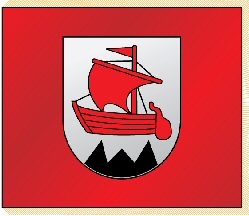 zachary harden
zachary harden
Keywords: prienai | kaunas | balbieriskis |
Links: FOTW homepage | search | disclaimer and copyright | write us | mirrors

Last modified: 2023-06-03 by  zachary harden
zachary harden
Keywords: prienai | kaunas | balbieriskis |
Links: FOTW homepage |
search |
disclaimer and copyright |
write us |
mirrors

image from <commons.wikimedia.org>
See also:
Town of Balbieriskis is in Prienai district in Kaunas county,
Lithuania. It has 1,180 inhabitants, and is the center of
Balbieriskis Eldership, which has 3,850 inhabitants.
From <www.jewishgen.org>:
"Located in Southwest Lithuania, on the left bank of the
Neiman River, approximately 18 kilometers northwest of the
railroad center of Alita (Alytus, cf.). The town developed
adjacent to the large estate established there in the beginning
of the 16th century. In 1520, it was awarded the privileges of a
city. However, during Prussian rule (1795-1807) this status was
withdrawn because of its small population. Between 1807-1815, it
was included in the territory of the Grand Duchy of Warsaw. In
1815, after Napoleon's defeat, it became Russian territory and
eventually was made part of Suvalk Province. Under Russian rule,
Balbirishok developed into an important commercial center. At the
end of the 19th century, when the rail line was laid to Alita and
Pren (Prienai), those two towns grew at the expense of
Balbirishok, whose importance declined. Between 1915-1918, during
World War I, the German army occupied the town. During
Lithuania's independence (1918-1940), Balbirishok was a
sub-district city."
Valentin Poposki, 8 March and 14 June 2007
Balbieriškis - on a red field the arms of Balbieriskis:
over an indented base a sailboat.
Flag proportions 5:6, fringe is golden, finial is a golden
knob.
Balbieriskis is named after the Barbiera rivulet, which is in
turn named after the Barbiera (also called Balbiera) rocks
in Nemunas River. Those rocks were dangerous for ships
navigating the Nemunas, till the water-power plant of Kaunas was
built, and the shoal was drowned. So the indented base means the
Barbiera rocks as the origin of town name, and the sailboat means
trade over the Nemunas River, which has grown the town.
Virginijus Misiunas, 28 February 2010